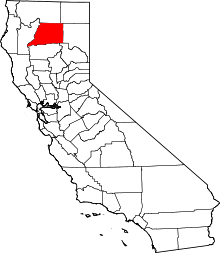Shasta, California
| Shasta | |
|---|---|
| census-designated place | |
 Shasta Position in California. | |
| Coordinates: 40°35′32″N 122°28′40″W / 40.59222°N 122.47778°WCoordinates: 40°35′32″N 122°28′40″W / 40.59222°N 122.47778°W | |
| Country |
|
| State |
|
| County | Shasta |
| Area[1] | |
| • Total | 10.982 sq mi (28.444 km2) |
| • Land | 10.978 sq mi (28.433 km2) |
| • Water | 0.004 sq mi (0.012 km2) 0.04% |
| Elevation[2] | 843 ft (257 m) |
| Population (2010) | |
| • Total | 1,771 |
| • Density | 160/sq mi (62/km2) |
| Time zone | UTC-8 (Pacific (PST)) |
| • Summer (DST) | UTC-7 (PDT) |
| GNIS feature ID | 2583135 |
| U.S. Geological Survey Geographic Names Information System: Shasta, California; | |
|
Shasta State Historic Park | |
| Location | Shasta, California |
| Architect | Multiple |
| Architectural style | Other |
| NRHP reference # | 71000199[4] |
| CHISL # | 77[3] |
| Significant dates | |
| Added to NRHP | October 14, 1971 |
| Designated CHISL | 1932 |
Shasta is a census-designated place (CDP) in Shasta County, California,[2] United States. Shasta sits at an elevation of 843 feet (257 m).[2] The 2010 U.S. Census reported Shasta's population was 1,771.
Shasta State Historic Park located at Shasta is a ghost town and California State Historic Park.
History
A bustling town of the 1850s through the 1880s, Shasta was for its time, the largest settlement in Shasta County and the surrounding area. Sometimes referred to today as "Old Shasta", the town was an important commercial center and a major shipping point for mule trains and stagecoaches serving the mining towns and later settlements of northern California. The discovery of gold near Shasta in 1848 brought California Gold Rush-era Forty-Niners up the Siskiyou Trail in search of riches - most passed through Shasta, and continued to use it as base of operations.
Situated about six miles (10 km) west of Redding, California along Highway 299, Shasta was once home to some 3,500 residents and a thriving commercial district. However, in the mid-1880s, the newly constructed Central Pacific Railroad bypassed Shasta, in favor of Redding and the town declined into "ghost town" status.
The poet Joaquin Miller refers to Shasta in his 1870s novel, Life Amongst the Modocs, based on the experiences of Miller as a young man living in the area in the 1850s. In this book, Miller describes his brief imprisonment in a Shasta jail for horse-stealing and subsequent escape with the aid of his Native American wife.
Shasta State Historic Park
The site of the town is now a California State Historic Park called Shasta State Historic Park, containing many of the original 19th century brick buildings, partially restored. Shasta is now a town with the ruins of the gold mining town, a post office, a church, the oldest Masonic lodge in California, and a store.
The park was damaged by the Carr Fire in 2018, during which the elementary school was destroyed and the brewery and cemetery were damaged.[5]
Geography
According to the United States Census Bureau, the CDP covers an area of 11.0 square miles (28.4 km²), 99.96% of it land and 0.04% of it water.
Demographics
The 2010 United States Census[6] reported that Shasta had a population of 1,771. The population density was 161.3 people per square mile (62.3/km²). The racial makeup of Shasta was 1,612 (91.0%) White, 11 (0.6%) African American, 37 (2.1%) Native American, 23 (1.3%) Asian, 1 (0.1%) Pacific Islander, 7 (0.4%) from other races, and 80 (4.5%) from two or more races. Hispanic or Latino of any race were 56 persons (3.2%).
The Census reported that 1,771 people (100% of the population) lived in households, 0 (0%) lived in non-institutionalized group quarters, and 0 (0%) were institutionalized.
There were 723 households, the average family size was 2.79.
The population was spread out with 339 people (19.1%) under the age of 18, 96 people (5.4%) aged 18 to 24, 291 people (16.4%) aged 25 to 44, 716 people (40.4%) aged 45 to 64, and 329 people (18.6%) who were 65 years of age or older. The median age was 50.6 years. For every 100 females, there were 106.7 males. For every 100 females age 18 and over, there were 101.7 males.
There were 782 housing units at an average density of 71.2 per square mile (27.5/km²), of which 621 (85.9%) were owner-occupied, and 102 (14.1%) were occupied by renters. The homeowner vacancy rate was 1.7%; the rental vacancy rate was 5.5%. 1,507 people (85.1% of the population) lived in owner-occupied housing units and 264 people (14.9%) lived in rental housing units.
Politics
In the state legislature Shasta is in the 1st Senate District, represented by Republican Ted Gaines,[7] and the 1st Assembly District, represented by Republican Brian Dahle.[8]
Federally, Shasta is in California's 1st congressional district, represented by Republican Doug LaMalfa.[9]
Notable people
References
- ↑ U.S. Census Archived 2012-01-24 at WebCite
- 1 2 3 U.S. Geological Survey Geographic Names Information System: Shasta, California
- 1 2 "Shasta". Office of Historic Preservation, California State Parks. Retrieved 2012-10-14.
- ↑ National Park Service (2008-04-15). "National Register Information System". National Register of Historic Places. National Park Service.
- ↑ "Carr Fire kills two firefighters near Redding, destroys 500 structures". SFChronicle.com. 28 July 2018. Retrieved 28 July 2018.
- ↑ "2010 Census Interactive Population Search: CA - Shasta CDP". U.S. Census Bureau. Retrieved July 12, 2014.
- ↑ "Senators". State of California. Retrieved March 10, 2013.
- ↑ "Members Assembly". State of California. Retrieved March 2, 2013.
- ↑ "California's 1st Congressional District - Representatives & District Map". Civic Impulse, LLC. Retrieved March 1, 2013.
